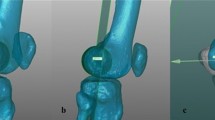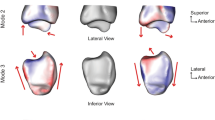Abstract
Purpose
The purpose of this work is to simulate radiographs from isotropic 3D MRI data, compare relationship of angle and joint space measurements on simulated radiographs with corresponding 2D MRIs and real radiographs (XR), and compare measurement times among the three modalities.
Materials and methods
Twenty-four consecutive ankles were included, eight males and 16 females, with a mean age of 46 years. Segmented joint models simulating radiographs were created from 3D MRI data sets. Three readers independently performed blinded angle and joint space measurements on the models, corresponding 2D MRIs, and XRs at two time points. Linear mixed models and the intraclass correlation coefficient (ICC) was ascertained, with p values less than 0.05 considered significant.
Results
Simulated radiograph models were successfully created in all cases. Good agreement (ICC > 0.65) was noted among all readers across all modalities and among most measurements. Absolute measurement values differed between modalities. Measurement time was significantly greater (p < 0.05) on 2D versus simulated radiographs for most measurements and on XR versus simulated radiographs (p < 0.05) for nearly half the measurements.
Conclusions
Simulated radiographs can be successfully generated from 3D MRI data; however, measurements differ. Good inter-reader and moderate-to-good intra-reader reliability was observed and measurements obtained on simulated radiograph models took significantly less time compared to measurements with 2D and generally less time than XR.









Similar content being viewed by others
References
Physician Resource Center. (2016) Ankle Sprain: Imaging Studies. American Orthopaedic Foot and Ankle Society. Accessed Oct 29, 2016. Available at https://www.aofas.org/PRC/conditions/Pages/Conditions/Ankle-Sprain.aspx
Sinatra PM, Moed BR. CT-generated radiographs in obese patients with acetabular fractures: can they be used in lieu of plan radiographs? Clin Orthop Relat Res. 2014;472(11):3362–9.
Gyftopoulos S, Beltran LS, Yemin A, et al. Use of 3D MR reconstructions in the evaluation of glenoid bone loss: a clinical study. Skelet Radiol. 2014;43(2):213–8.
Anastasi G, Cutroneo G, Bruschetta D, et al. Three-dimensional volume rendering of the ankle based on magnetic resonance images enables the generation of images comparable to real anatomy. J Anat. 2009;215:592–9.
Udupa JK, Hirsch BE, Hillstrom HJ, Bauer GR, Kneeland B. Analysis of in vivo 3-D internal kinematics of the joints of the foot. IEEE Trans Biomed Eng. 1998;45(11):1387–96.
Siegler S, Udupa JK, Ringleb SI, et al. Mechanics of the ankle and subtalar joints revealed through a 3D quasi-static stress MRI technique. J Biomech. 2005;38:567–78.
Falcao AX, Udupa JK, Samarasekera S, Sharma S, Hirsch BE, Lotufo R. User-steered image segementation paradigms: live wire and live lane. Graphical Models Image Proc. 1998;60:233–60.
Hoad CL, Martel AL. Segmentation of MR images for computer-assisted surgery of the lumbar spine. Phys Med Biol. 2002;47:3507–17.
Ababneh SY, Prescott JW, Gurcan MN. Automatic graph-cut based segmentation of bones from knee magnetic resonance images for osteoarthritis research. Med Image Anal. 2011;15:438–48.
Xia Y, Fripp J, Chandra SS, Schwarz R, Engstrom C, Crozier S. Automated bone segmentation from large field of view 3D MR images of the hip joint. Phys Med Biol. 2013;58:7375–90.
Schmid J, Kim J, Megnenant-Thalmann N. Robust statistical shape models for MRI bone segmentation in presence of small field of view. Med Image Anal. 2011;15:155–68.
Fripp J, Crozier S, Warfield SK, Ourselin S. Automatic segmentation of the bone and extraction of the bone-cartilage interface from magnetic resonance images of the knee. Phys Med Biol. 2007;52:1617–31.
Chhabra A, Nordeck S, Wadhwa V, Madhavapeddi S, Robertson WJ. Femoracetabular impingement with chronic acetabular rim fracture – 3D computed tomography, 3D magnentic resonance imaging and arthroscopic correlation. World J Orthod. 2015;6(6):498–504.
Nordeck S, Flanagan J, Tenorio L, Robertson W, Chhabra A. 3-D isotropic MR imaging for planning bone reconstruction in patients with femoracetabular impingement. Radiol Technol. 2015;87(1):21–8.
Fleiss JL. The design and analysis of clinical experiments. New York: Wiley; 1986.
Kijowski R, Blankenbaker DG, Woods M, Munoz Del Rio A, De Smet AA, Reeder SB. Clinical usefulness of adding 3D cartilage imaging sequences to a routine knee MR protocol. Am J Roentgenol. 2011;196:159–67.
Van Bergen CJA, Tuijthof GJM, Blankevoort L, Maas M, Kerkhoffs GMMJ, Van Neik Dijk C. Computed tomography of the ankle in full planter flexion: a reliable method for preoperative planning of arthroscopic access to osteochondral defects of the talus. J Arthrosc Relat Surg. 2012;28(7):985–92.
Black EM, Antoci V, Lee JT, et al. Role of preoperative computed tomography scans in operative planning for malleolar ankle fractures. Foot Ankle Int. 2013;34(5):697–704.
Huppertz A, Radmer S, Asbach P, et al. Computed tomography for preoperative planning in minimal-invasive total hip arthroplasty: Radiation exposure and cost analysis. Eur J Radiol. 2011;78:406–13.
Wu D, Sofka M, Birkbeck N, Zhou SK. Segmentation of multiple knee bones from CT for orthopedic knee surgery planning. Med Image Comput Comput Assist Interv. 2014;17(Pt 1):372–80.
Acknowledgements
The authors wish to thank Jon Garinn, M.J. for his editorial work in the preparation of this manuscript.
Author information
Authors and Affiliations
Corresponding author
Ethics declarations
Disclosures
Financial support for this study was provided exclusively by the authors’ affiliated department. The authors report no conflict of interest directly related to this study.
One author A.C. reports grants from GE-AUR (GERRAF), grants from Siemens Medical Solutions, grants from Integra Life Sciences, grants from Gatewood Fellowship Award, personal fees from Siemens CAD Group, outside the submitted work.
Rights and permissions
About this article
Cite this article
Nordeck, S.M., Koerper, C.E., Adler, A. et al. Simulated radiographic bone and joint modeling from 3D ankle MRI: feasibility and comparison with radiographs and 2D MRI. Skeletal Radiol 46, 651–664 (2017). https://doi.org/10.1007/s00256-017-2596-7
Received:
Revised:
Accepted:
Published:
Issue Date:
DOI: https://doi.org/10.1007/s00256-017-2596-7




